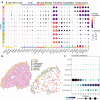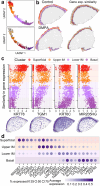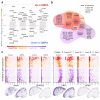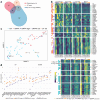Spatial transcriptomics unveils estrogen-modulated immune responses and structural alterations in the ectocervical mucosa of depot medroxyprogesterone acetate users
- PMID: 39762272
- PMCID: PMC11704007
- DOI: 10.1038/s41598-024-83775-9
Spatial transcriptomics unveils estrogen-modulated immune responses and structural alterations in the ectocervical mucosa of depot medroxyprogesterone acetate users
Abstract
The injectable contraceptive, depot medroxyprogesterone acetate (DMPA), is associated with compromised cervical mucosal barriers. High-resolution spatial transcriptomics is applied here to reveal the spatial localization of these altered molecular markers. Ectocervical tissue samples from Kenyan sex workers using DMPA, or non-hormonal contraceptives, underwent spatial transcriptomics and gene set enrichment analyses. Integrated systemic estradiol levels and bulk tissue gene expression data from a larger cohort enhanced the study's scope. Unsupervised clustering unveiled four epithelial and seven submucosal layers, showcasing spatially restricted and diverse functional epithelial responses, and a less structured submucosal spatial ordering. DMPA associated with mucosal-wide immunoglobulin gene upregulation, verified by CD20+ B-cell immunostaining, and upregulated immune markers adjacent to the basal membrane. Downregulated genes represented spatially restricted disrupted epithelial barrier integrity and submucosal extracellular matrix dysfunction. The transcriptional profile was associated with markers of estrogen regulation. Collectively, our findings reveal estrogen-modulated distinct ectocervical transcriptional profiles associated with DMPA usage. While upregulation of immunoglobulin genes occurs throughout the mucosa, activation of innate immune responses and dysregulation of barrier integrity markers are spatially restricted. These results extend previous analyses using bulk transcriptomics and provide insights into the molecular landscape influenced by DMPA, shedding light on contraceptive effects and health implications.
Keywords: DMPA; Ectocervix; Estrogen; Hypoestrogenemia; Mucosa; Spatial transcriptomics.
© 2025. The Author(s).
Conflict of interest statement
Declarations. Competing interests: The authors declare no competing interests, except for Paulo Czarnewski who currently works at Precisium AI as Chief Executive Officer.
Figures







Similar articles
-
Increased Cervical CD4+CCR5+ T Cells Among Kenyan Sex Working Women Using Depot Medroxyprogesterone Acetate.AIDS Res Hum Retroviruses. 2019 Mar;35(3):236-246. doi: 10.1089/AID.2018.0188. Epub 2019 Jan 24. AIDS Res Hum Retroviruses. 2019. PMID: 30585733 Free PMC article.
-
Use of contraceptive depot medroxyprogesterone acetate is associated with impaired cervicovaginal mucosal integrity.J Clin Invest. 2018 Oct 1;128(10):4622-4638. doi: 10.1172/JCI120583. Epub 2018 Sep 17. J Clin Invest. 2018. PMID: 30222141 Free PMC article. Clinical Trial.
-
Multi-omics analysis of the cervical epithelial integrity of women using depot medroxyprogesterone acetate.PLoS Pathog. 2022 May 9;18(5):e1010494. doi: 10.1371/journal.ppat.1010494. eCollection 2022 May. PLoS Pathog. 2022. PMID: 35533147 Free PMC article.
-
An updated review on the effects of depot medroxyprogesterone acetate on the mucosal biology of the female genital tract.Am J Reprod Immunol. 2021 Sep;86(3):e13455. doi: 10.1111/aji.13455. Epub 2021 Jun 12. Am J Reprod Immunol. 2021. PMID: 33991137 Free PMC article. Review.
-
Depot medroxyprogesterone acetate contraception and the risk of breast and gynecologic cancer.J Reprod Med. 1996 May;41(5 Suppl):419-27. J Reprod Med. 1996. PMID: 8725705 Review.
References
-
- United Nation Department of Economic and Social Affairs. 25. Contraceptive use by method 2019: data booklet. Contraception Use by Method (2019).
-
- Plummer, F. A. et al. Cofactors in male-female sexual transmission of human immunodeficiency virus type 1. J. Infect. Dis.163, 233–239 (1991). - PubMed
Publication types
MeSH terms
Substances
LinkOut - more resources
Full Text Sources

